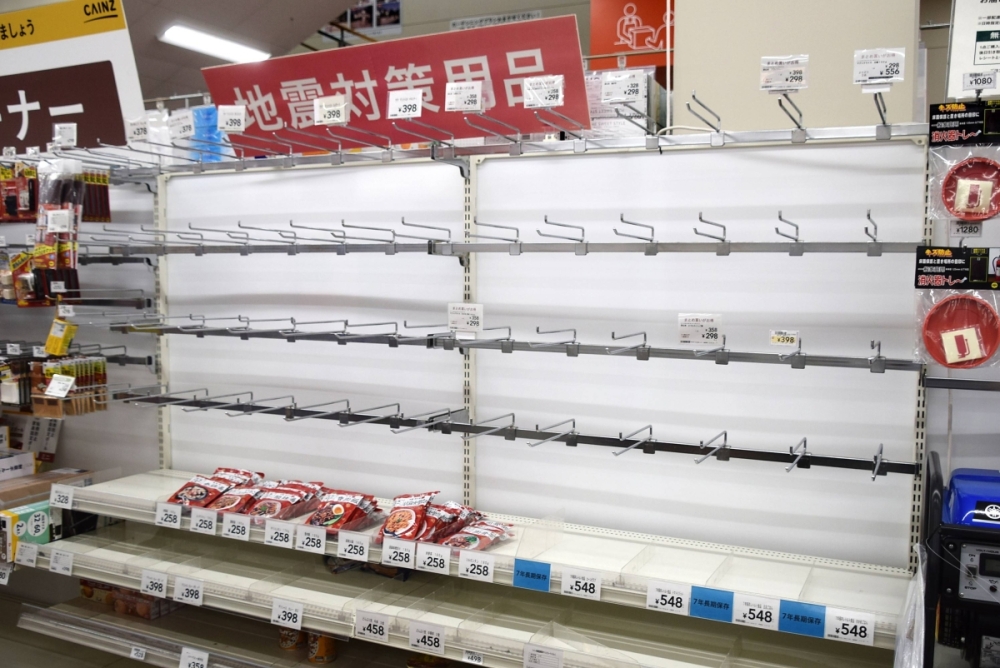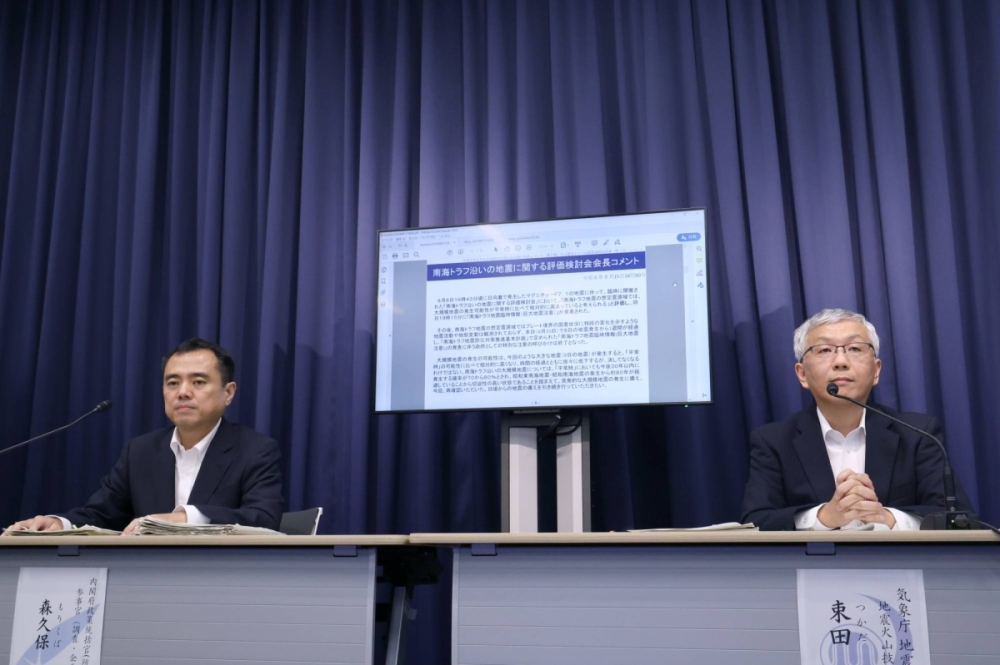As individuals rushed to high up their emergency kits, officers tried to obviously state what the advisory actually meant — it wasn’t a forecast, and the possibility of a giant quake was solely seen as being barely increased — however not less than initially, confusion reigned.
The episode put a renewed highlight on a long-simmering debate inside the scientific group about whether or not earthquakes may be predicted. Supporters say it’s about lowering danger, however critics see a system that isn’t primarily based on science and one by which the cons outweigh the professionals.
The present system for issuing emergency data was established in 2019, evolving from a short lived framework launched by the Meteorological Agency in 2017, put in place till new catastrophe prevention methods had been carried out.
The authorities categorizes earthquake warnings into three ranges of urgency.
The lowest, “further data,” describes the necessity for additional evaluation. The second degree — which was issued in August — may be actually translated as “megathrust earthquake consideration,” and is issued following a big quake within the Nankai Trough space. It warns of the potential of one other massive quake and advises individuals to arrange for potential quakes, equivalent to by securing furnishings, confirming evacuation routes, checking emergency provides and making certain technique of communication with household.
The highest degree is a “megathrust earthquake alert,” that means a magnitude 8 or larger earthquake has occurred at a plate boundary and one other might quickly observe. The authorities would then name on the general public to evaluation preparedness and urge the evacuation of individuals needing particular care and people in notably weak areas who might not be capable to evacuate if a quake hits.
The system sat dormant for 5 years till Aug. 8, when a magnitude 7.1 earthquake struck off the coast of Miyazaki Prefecture. News experiences tracked the story, which unfolded in a dramatic arc — a giant quake, a tsunami advisory, an all clear — after which a discover that appeared to recommend the Big One was coming.
Echoes of doubt
Manabu Hashimoto, a former director at Kyoto University’s Disaster Prevention Research Institute, is amongst those that have questioned the effectiveness of the advisory system.
He argues that issuing such advisories, particularly since they contain such low chances of round 0.5% to 0.6% for a Nankai Trough earthquake over a one-week interval, might result in pointless disruptions.
Issuing advisories just like the one in August would possibly result in pointless social and financial disruptions, Hashimoto mentioned, including that if individuals begin to obtain such warnings often, it might improve the danger of complacency.
“We ought to keep ready as if a significant occasion might happen at any time,” he mentioned. “In that sense, this advisory represents an ongoing state of vigilance that ought to proceed indefinitely.”
Hashimoto mentioned the federal government will not be successfully offering the data wanted for knowledgeable decision-making by the general public, however he famous that consultants additionally battle to speak the uncertainty and low chance concerned within the system.

A Self-Defense Forces member leads residents in an remoted space of Wajima, Ishikawa Prefecture, to a helicopter on Jan. 6 within the aftermath of a significant earthquake on the Noto Peninsula.
| Reuters
Takeshi Sagiya, a professor at Nagoya University’s Disaster Mitigation Research Center, is one other critic of the system, pointing to the preliminary public confusion surrounding the advisory.
“I’ve been fairly skeptical concerning the effectiveness of this warning system from the start,” Sagiya mentioned.
Experts together with Sagiya and Hashimoto have additionally expressed considerations about focusing an excessive amount of on particular areas, as the federal government has with the Nankai Trough.
Before the 1995 Great Hanshin Earthquake, the federal government’s focus for earthquake preparedness was solely on the Tokai area, main individuals within the Kansai area to consider {that a} quake in Kobe was unlikely, Hashimoto mentioned.
“The authorities is repeating the identical errors,” he mentioned, emphasizing the necessity for a extra balanced strategy that features preparation for surprising earthquakes in less-discussed areas.
Sagiya, in the meantime, famous what he sees as issues with the science, expressing concern that catastrophe preparedness and official measures for quakes rely too closely on speculative theories missing enough proof. The present chance estimates for the Nankai Trough earthquake are additionally closely primarily based on such speculative fashions, he added.
In 2013, the chance of a magnitude 8 or larger earthquake occurring all through all the Nankai Trough inside the subsequent 30 years was estimated to be between 60% and 70%. As they had been primarily based on historic earthquake intervals, they’re about 10 proportion factors decrease than right now’s 70% to 80%, Sagiya mentioned.
But if the speculative fashions are put apart, he mentioned, the determine might fall to 30% or decrease.
He added that Japan’s strategy tends to spotlight the best chance as a way to emphasise the necessity for preparedness, however that utilizing a spread or common could be extra applicable.

Empty cabinets at a house heart in Shizuoka on Aug. 9 after clients purchased up bottled water to arrange for the potential of a significant earthquake originating within the Nankai Trough
| Jiji
Sagiya cautioned that specializing in the estimate of a 70% to 80% chance that an M8 to M9 earthquake will happen within the Nankai Trough inside the subsequent 30 years, a catastrophe that may have an estimated dying toll of a whole lot of hundreds of individuals, dangers “unnecessarily heightening anxiousness” and may lead individuals to miss different still-vulnerable areas, making a false sense of safety.
Sagiya cited January’s quake off the Noto Peninsula as an exceptionally uncommon occasion, thought to happen roughly as soon as each 3,000 years in that area. Despite this low chance, he emphasised that earthquakes can strike wherever.
Hashimoto echoed Sagiya’s considerations.
“Defining a worst-case situation scientifically is sort of unattainable,” he mentioned, noting that frequent harm prediction fashions are extra aligned with engineering, even when they contain some scientific components. “In essence, a lot of the warning system’s work will not be purely scientific.”
A social experiment?
Still, some consultants see worth within the alert system.
Shinichi Sakai, of the University of Tokyo’s Earthquake Research Institute, mentioned it is essential to grasp the target behind the advisory — its major objective, he mentioned, is to cut back the potential harm from a catastrophe.
“While we can’t forestall earthquakes, the goal is to reinforce preparedness in order that when an earthquake happens, the probability of minimizing harm and growing possibilities of survival is improved,” he mentioned.
He acknowledged that evaluating the effectiveness of such advisories is difficult since trials can’t be carried out repeatedly, and their impression can’t be instantly assessed.
Despite this, he added, researchers can study from how individuals react, which might give perception into the way to refine future communication methods and assess the general system.
“Understanding how individuals interpret and act upon such notices is essential. We want to think about the way to talk such warnings successfully,” he mentioned.

An almost empty seashore in Hiratsuka, Kanagawa Prefecture, on Aug. 10 following warnings of the potential of a significant earthquake originating within the Nankai Trough
| Jiji
But Sagiya takes concern with what he sees as a “social experiment.”
“It appears like all the nation is collaborating in an experiment,” he mentioned. “As if the Meteorological Agency is observing how society reacts when such data is issued,” and turning residents into “experimental topics.”
While he admitted this can be a harsh characterization, he questioned whether or not the system is appropriate.
Sakai mentioned that, whereas the advisory did function a sort of experiment, it highlights the necessity for steady enchancment.
“To higher put together for precise occasions, it’s essential to conduct repeated drills and repeatedly refine the method,” he mentioned. “This iterative strategy helps develop simpler methods for real-life conditions.”
He in contrast this concept to crime prevention, noting that, simply as with pure disasters, the most effective strategy is to keep away from dangerous conditions and be on guard for potential threats.
“We can’t really feel utterly relaxed — I don’t assume we’ll ever attain a degree the place we may be really assured,” Sakai mentioned. “But all we will do is make it higher.”
Awareness, not prediction
Naoshi Hirata, chairperson of the Meteorological Agency’s Nankai Trough Earthquake Assessment Committee, which screens and supplies knowledgeable recommendation on collected knowledge from the Nankai Trough area, emphasised that the August advisory was not a prediction however an effort to boost public consciousness about earthquake preparedness.
“The advisory was there to nudge individuals to evaluation how ready they’re for an earthquake,” he mentioned, including that the federal government didn’t suggest canceling journey plans or avoiding coastal areas. “We didn’t inform individuals to evacuate.”
The Center for Integrated Disaster Information Research on the University of Tokyo performed an internet survey from Aug. 9 to 11 to measure behavioral modifications following the Nankai Trough advisory. The survey acquired a complete of 9,400 responses from people between the ages of 20 and 69.

Emergency provisions are bought out at a retailer in Shizuoka on Aug. 9.
| Jiji
The modifications in conduct following the advisory had been restricted, in line with the survey, with solely a small proportion of respondents saying they took particular actions — 19.7% mentioned they checked provides equivalent to water and meals, 9.2% confirmed communication strategies with household, and eight.1% ensured measures to stop furnishings from tipping over. Only 2.1% indicated that that they had modified their journey or leisure plans.
Hirata mentioned the advisory served to encourage individuals to test evacuation routes in case a tsunami warning or a top-level alert is issued.
“Many individuals realized about this method for the primary time and weren’t positive what to do,” he mentioned.
“But knowledge confirmed that most individuals acted calmly, and there was little or no panic.”
One vital achievement by means of the advisory, Hirata mentioned, citing the research, is that over 80% of individuals now not less than perceive that such advisories could possibly be issued.
The University of Tokyo research confirmed that 83% of individuals heard concerning the advisory.
Hirata acknowledged that, regardless of the various predictions, the federal government focuses on the worst-case situation to make sure complete measures are taken.
“Quakes are unpredictable, however hazards may be forecasted,” he mentioned.

Officials maintain a information convention in Tokyo on Aug. 15 to announce the top of a particular warning over the potential of a significant Nankai Trough earthquake.
| Jiji
Hirata compares the scenario to flashing your automobile’s hazard lights on the freeway as a strategy to sign congestion forward. However, merely having these lights flashing would not all the time forestall accidents — it exhibits that with out correct precautions, accidents might occur. In essence, he mentioned, evaluating hazards, such because the probability of an earthquake, is about speaking potential dangers in order that applicable measures may be taken.
That’s the place the advisory system is available in, and Hirata notes that earthquakes are certainly more likely to happen in succession.
Nankai Trough quakes typically are available in pairs, Hirata mentioned, including that when a magnitude 8 earthquake happens, there’s roughly a ten% probability that one other earthquake of magnitude 8 or larger will observe.
Many individuals mistakenly consider it’s secure after a giant quake, or that one must be anticipated after a protracted interval of quiet, however Hirata calls this a fantasy.
He sees the larger image as being one thing way more vital than only a matter of chance, and indicated that worry could be a wholesome associate for preparedness.
“In the primary place, earthquakes are pure phenomena that happen underground, and so they solely change into disasters when society fails to reply appropriately,” Hirata mentioned.
“We should be fearful in the best method.”




